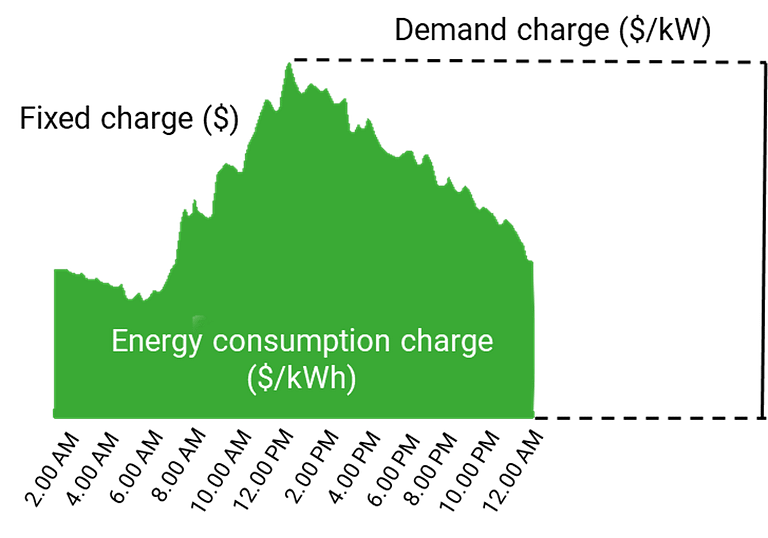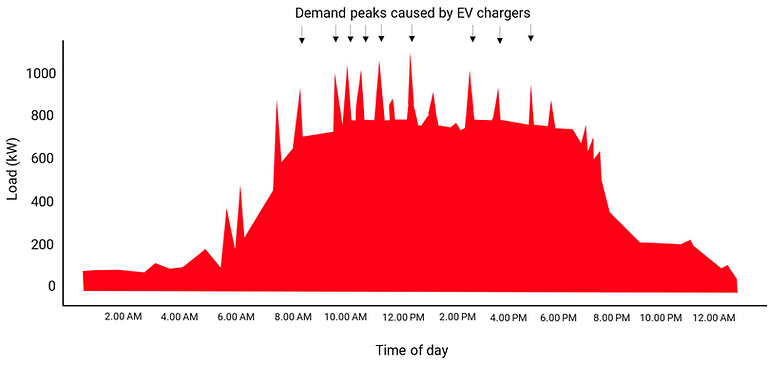Battery energy storage can dramatically reduce electrical demand charges for businesses looking to introduce electric vehicle charging. Demand charges are a significant barrier to deploying EV charging. With over 27% of commercial utility customers in the USA having access to tariffs over $15 per kilowatt in demand charges, it is easy to see why so many businesses have been holding off from implementing electric vehicle charging. However, companies can dramatically reduce these demand charges with the right-sized battery energy storage system. The overall total cost of ownership lowered, giving a much better return on investment for businesses that implement EV charging stations at their sites.
UTILITY CHARGES ON AN ELECTRIC BILL
Let’s look at utility charges on an electric bill for a commercial business. There are typically three types of charges.
- Fixed charges ($)
- Covers the administrative costs to serve customers
- Usually, a monthly fixed rate
- Energy consumption charge ($/kWh)
- Contributed towards the cost of energy generation
- A monthly charge for each grid-supplied kWh
- Demand charge
- Contributed towards the cost of grid infrastructure
- A monthly charge for the highest 15-minute kW grid offtake
The graph below visually shows the difference between the charges on an electric bill. During this article, we will be focusing on demand charges and how to reduce them.

WHAT IS A DEMAND CHARGE, AND HOW DO THEY WORK?
A demand charge is usually calculated based on the highest average electricity usage within a defined period, typically 15 minutes, during a billing cycle. Unlike energy consumption charges, which account for the volume of electricity consumed in kWh (kilowatt-hours) during the billing cycle, demand charges track the highest rate of electricity used in kW (kilowatt). The greater the requirement for electricity at any time during the billing cycle, the higher the customer’s demand.
Demand charges can vary considerably across utilities, locations, and building sizes. In particular examples, customers can see demand charges accounting for over 50% of their energy bill during a billing cycle. Demand charges are designed to contribute towards utilities providing the operation and maintenance of electrical infrastructure that enables sufficient electricity generation and distribution capacity; the costs are distributed to those businesses who have the most need for increased capacity. The higher your peak power usage, the higher your overall demand charges.
We are going to focus on demand charges; we will show you how EVESCO battery energy storage can reduce electrical demand charges, enabling a faster return on investment when implementing electric vehicle charging stations. First, we must look at how the addition of EV chargers can affect your peak power demand and your demand charges.
THE IMPACT OF EV CHARGING ON DEMAND CHARGES
When adding DC fast-charging stations, your peak demand usage can increase by the rated output power of the charger. For example, if you install one 50kW fast charger, your peak demand would increase by 50kW when that charger is used. If you have demand charges of $30, this could amount to $1,500 extra per billing cycle. This example is for one 50kW charger only. The demand charges start to stack up when you consider faster chargers up to 350kW or multiple chargers for businesses with working fleet vehicles, lots of customer demand, or even car dealerships that need to charge newly delivered EVs simultaneously. The higher the demand for kW power, the higher the demand charges.
HOW TO REDUCE DEMAND CHARGES WITH BATTERY ENERGY STORAGE
The below graph shows a typical commercial building’s electrical load profile; you can see that the business starts operating around 6 am and closes up between 8 pm and 9 pm. The load profile would include the lighting, heating, air conditioning, computers, and any other electrical loads needed for operating the business during those hours. You can see where the demand charges start to play with the spikes in the load profile. These spikes represent a 150kW DC fast charger in use. You can see by the spikes that the charger is being used for a short frequency, with electric cars pulling up to charge and then leaving.

HOW BATTERY ENERGY STORAGE REDUCES PEAK DEMAND
As you can see below, with the addition of battery energy storage, the peak demand spikes are smoothed out, which will result in reduced demand charges. Illustrated on the graph, we charge the batteries from the grid during off-peak times as it doesn’t increase the overall demand charge. We then use that stored energy to power the EV charger when there is usually peak demand. Battery energy storage enables the shaving off of the peaks caused by EV charging, resulting in a flatter load profile during the highest charges of the day and then charging the batteries again during the evening.

So we know that EV charging stations will increase the overall demand charges, but we are also seeing that in many states, the amount charged per kW for demand charges by utilities is rising. As commercial customers can reduce their utility bills by utilizing on-site solar to reduce energy consumption charges (kWh), utilities are putting more of their fees into the demand for power as they align electric load profiles with the cost of the infrastructure. In some cases in the US, we see 3 – 5% increases in demand charges annually, but in some states, some utility companies are increasing demand charges at a much faster rate. The increasing costs for demand charges make battery energy storage an even more attractive option to combine with your electric vehicle charging implementation.
WHEN DOES BATTERY ENERGY STORAGE MAKE SENSE?
Combining your EV charging with battery energy storage makes sense for various reasons. Not only does it reduce demand charges, but it can increase output power enabling fast charging in locations with limited electric grid supply. At EVESCO, we work with you to ensure that every EV Charging + Storage project makes sense commercially. As a rough guide, if your demand charges are over $20/kW, you could get an attractive payback period with energy storage. On top of that, there are several energy storage incentives and electric vehicle charging infrastructure incentives available through federal and local governments and utility companies, which make the payback period even shorter. The incentives for EV charging and energy storage often overlap well, so there are opportunities for incentives for both areas, further lowering the total cost of ownership.
SIZING THE BATTERY ENERGY STORAGE SYSTEM
One essential thing is that your battery energy storage system is sized correctly for your EV charging implementation. Some factors that need considering are:
- The size and expected usage of your EV chargers. You need to ensure that the demand for the chargers is taken into consideration when sizing the battery energy storage. If demand is higher than expected on the EV chargers, you could end up with some demand charges for having an undersized system. Suppose you need multiple EV chargers intended to be used simultaneously. In that case, this also needs to be considered as you want to ensure the battery storage can cover the maximum peak power. Are the chargers used back-to-back throughout the day, infrequently, or for long periods? All this needs to be considered when sizing the battery storage system.
- Oversizing the system. If you oversize the battery system, this will affect the economics, and it will take longer to see a return on investment.
- Other considered areas include existing and future electrical load profiles, on-site renewables, volatility of electrical load profile, peak-demand period, incentives, and much more.
It can all get a little complicated, so this is why you need a strong partner, like EVESCO, helping you size your system and working with you on an implementation strategy.
DC fast EV charging and battery energy storage work well together in combination. DC chargers have forecastable peak power, which helps when sizing a system and understanding the electrical load profile. The energy storage system can monitor the EV charger and know when it is used, quickly discharging energy from the battery. As DC fast chargers are used for relatively short periods, it utilizes the full power of the inverter, maximizing the battery to inverter ratio for the most cost-effective and efficient solution.
If peak demand charges are over $20/kW and you are looking at introducing EV charging, battery energy storage from EVESCO will help reduce total demand charges and offer you a quicker payback.







